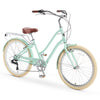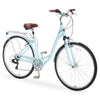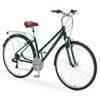Understanding the Basics of Beach Cruiser Bikes
Copy Link
http://www.sixthreezero.com/blogs/bike-advice/basics-of-beach-cruiser-bikes
Intro to Beach Cruiser Bikes
When you know how your bike works you’ll enjoy riding even more. While just like a car you can ride beach cruisers bikes without knowing the ins and outs of their operation, knowing how gears, brakes, and parts work in-depth can save you time, money, and make you safer when out cycling.
Yet, it can be hard to know where to begin when wanting to learn, because many guides are either too dense or dry -- and you just want to learn quickly before you get out and start riding more! Let’s make it easy for you here then, and now walk you through the basics of beach cruiser bikes...
Frame
The frame is where it all begins for beach cruiser bikes. Just like runners discuss shoes and car fans talk about engines, most regular cyclists are always ready to have in-depth discussions about different frames and their virtues. As a new cyclist you don’t need to worry about all of these details right now, but having a good understanding of the importance of a frame to your beach cruiser bike is worthwhile.
At its core, the central issue with frames is weight. A good frame will be light, a bad frame heavy. While a lighter frame is desirable, as it’s easier to ride faster and exert less energy, a bike also needs to be strong enough to carry its rider, and withstand regular wear and tear.
For this reason, bike frames that are light and strong are more expensive, while lower-cost beach cruisers and other more affordable bikes will be heavier (but also strong). Ultimately, a new cyclist doesn't need to worry too much about the weight of their new bike, but instead focus on maintaining the frame.
In addition to being careful to not put strain on the bike’s frame (a road bike designed for racing should not have a book bag installed on it to carry college books, for example), it is also important to watch for signs of wear and tear. As a rule, beach cruiser bikes are strong and can withstand most minor crashes, but a hard or serious crash that has cracked the frame (in addition to leaving the rider sore) means frame repair or replacement will be necessary.

Gears
Gears are the most important part of a multi speed beach cruiser bike. Sure, you need pedals to power it, and handlebars to steer your ride, but just like how a car’s engine determines what sort of vehicle it is, a bike’s gears determine what sort of bike it is.
If you have a fixie bike, you will not need to worry about gears at all given you’ve got a single speed ride. The same applies if you’ve got a commuter bike, which usually only needs a gear change or two per journey. Even so, understanding how a multispeed beach cruiser bike’s gears work can help make you a more effective cyclist as you pedal around town.
Whether a road or mountain bike, a number of gears will be featured on the bike. Usually between 12 and 20 gears, a bike will have the option to switch gears via a paddle shift on the handlebars, as well as provide for switching from one chain ring to another (which allows you to switch from the high gears to the low gears if riding on a course that requires a significant scale of gear change). For new cyclists, an understanding of how to most effectively use the gears is more important than understanding everything about the gears themselves.
Put simply, a rider’s use of the bike should determine the gear they select -- not the other way around. This means if you are a strong cyclist that finds it easy to ride up hills, shifting up to a gear that gives you more power as you do may be wise, but is not essential. By contrast, if you are a cyclist who wishes to challenge yourself while riding a hill, shifting down to a gear that will take away power from the pedals and make it harder to climb is certain to give you a good workout.
Ultimately, however many gears you use and whatever scenarios you encounter while riding, seeking to maintain a regular cadence of between 80-100 rpm is a solid guide to your effectiveness when pedaling, as well as a good target for those trying to learn which gear to shift to when requiring a change.

Pedals
Depending on whether you have brought your bike already assembled or had one built, it's common for many beach cruiser bikes to be sold without pedals. As a result, you’ll often have a choice of pedals. While a huge variety exists in the cycling world, there are three main types of pedals in use today: the regular, the clipless, and the toe cage.
The regular pedals are those that anyone who has ever ridden a bike will recognize immediately. They are flat, square, and provide a big surface area for the rider’s foot to push down on. While these pedals can be a drawback for those riding at high speed, as it’s easy to lose your footing, for a newcomer to cycling they represent a good start point.
After a while riding with regular pedals, many cyclists look to transition to clipless riding. By utilizing a clip that allows a rider to click in their cycling shoe to the pedal, this allows the rider to have a more fluid experience powering the bike, similar to the experience of using a manual over an automatic car. While clipless pedals are the default choice for all professional cyclists, they can come with a sharp learning curve, and be frustrating to use in an area with much traffic and a lot of stop and start cycling. This is why multi speed beach cruiser bikes often stick to regular pedals.
The toe cage pedals are like a regular set of pedals but come with a 3 pronged rubber cover atop the pedal. By using this style of pedal when cycling, a rider is able to ‘strap in’ and simulate the clipless style of pedal, while also being able to use regular shoes as they ride. The drawback to these pedals is it can be harder to insert and remove your feet than all other kinds.

Brakes
Brakes are the most important part of a bike for a new cyclist. Knowing your brakes well, and understanding how they work, can be the difference between stopping safely in time and going to the doctor with some nasty cuts and bruises (or worse).
A bike with handlebar brakes will have two brakes on it: the front and the rear. The front brake will be on your bike’s left handlebar, and the rear on your right. The front brake is the ‘go to’ brake when a cyclist needs to stop. While some new riders have a fear that using the front brake could make them topple over the handlebars, in practice an adult cyclist should have sufficient weight on the back of the bike to prevent this from happening.
The only time a rear brake should be used first instead of a front brake is if a rider needs to stop but is unable to use the front brake at the time. Examples of this is going over a pothole, a trail of ice, or any other hazard on the road that would hinder the front brake’s ability to operate.
Depending on where you live in the world, the setup of your bike can differ when it comes to your brakes. While any bike sold in the US will have the left brake controlling the front brake, and the right the rear brake, it can differ with foreign and imported bikes. So, while it is wonderful that your uncle or Italy or aunty in France just sent you a beautiful new road bike, be sure you check out the brakes before racing it down the street.
Ultimately, whatever setup your brakes have, it is crucial a new rider avoids ‘grinding’ them to a stop. If a rider needs to come to a stop, it is best to use the front brake first, the rear brake if also required, and if still requiring a faster rate of braking, ‘pumping’ the brakes by alternating between the front and rear is best practice.
Not only does this technique avoid wearing down your brake pads too rapidly, but also prevents the risk of your tires overheating and experiencing a blowout. As with all rules, there is an exception here. If a sudden and immediate hazard appears in a cyclist’s path, then seeking to put full pressure on the brakes may be required. It is just important that this is a rare rather than a common practice.

Overview of Beach Cruiser Bikes
In addition to getting a good bike that fits you, so too is it important to look into a bike’s frame. Further, ensuring you’ve got the perfect seat that suits your frame, the ideal pedals to deliver you the most power when you ride, and maintaining essential components that wear overtime like your grip tape, brake pads, and more, are all part of being a skilled cyclist.
Ultimately, just like being a great cyclist, assembling beach cruiser bikes takes some time, experience, and an understanding of the best way to bring together a number of parts to deliver the best result. Best of all, by learning the basic ins and outs of how beach cruiser bikes work, a cyclist can use that knowledge to their benefit when out riding, and build significant skills and abilities as a rider.
Join the Journey Club at sixthreezero to uncover new and exciting ride locations around the globe!
Take our Free Body Fit Questionnaire
Similar Articles
If you fall outside the average measurements of most folks, you know that sizing items are...
Getting started when biking uphill, it's going to be hard when you start off, especially if...
Now that spring is here, it's sunny, you definitely want to get that vitamin D and...















